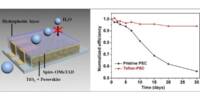One of the main challenges with renewable energy sources like wind and solar is their intermittent nature, which makes predicting how much energy they will produce at any given time difficult. This can pose difficulties for grid operators, who must balance supply and demand in real-time to ensure a stable and reliable supply of electricity.
Lower electricity costs for consumers and more reliable clean energy could be some of the benefits of a new study by the University of Adelaide researchers who investigated how predictable solar or wind energy generation is and its impact on electricity market profits.
Ph.D. student Sahand Karimi-Arpanahi and Senior Lecturer Dr. Ali Pourmousavi Kani from the University’s School of Electrical and Mechanical Engineering investigated various methods of achieving more predictable renewable energy with the goal of saving millions of dollars in operating costs, preventing clean energy spillage, and delivering lower-cost electricity.
“One of the biggest challenges in the renewable energy sector is being able to reliably predict the amount of power generated,” said Mr Karimi-Arpanahi.
One of the biggest challenges in the renewable energy sector is being able to reliably predict the amount of power generated. Owners of solar and wind farms sell their energy to the market before it is generated; however, there are significant penalties if they fail to deliver on their promises, which can amount to millions of dollars per year.
Mr. Karimi-Arpanahi
“Owners of solar and wind farms sell their energy to the market before it is generated; however, there are significant penalties if they fail to deliver on their promises, which can amount to millions of dollars per year. Peaks and troughs are a reality of this type of power generation; however, using energy generation predictability as part of the decision to locate a solar or wind farm allows us to minimize supply fluctuations and better plan for them.”
The team’s research, published in the data science journal Patterns, examined six existing solar farms in New South Wales, Australia, and chose up to nine alternative sites, comparing the sites based on the current analysis parameters and when the predictability factor was also taken into account.

The data revealed that the optimal location changed when the predictability of energy generation was taken into account, resulting in a significant increase in the site’s potential revenue. According to Dr. Pourmousavi Kani, the findings of this paper will be important for the energy industry in planning new solar and wind farms as well as public policy design.
“Researchers and practitioners in the energy sector have frequently overlooked this aspect,” he said, “but our study will hopefully lead to change in the industry, better returns for investors, and lower prices for customers.”
“The predictability of solar energy generation is the lowest in South Australia each year from August to October while it is highest in NSW during the same period. In the event of proper interconnection between the two states, the more predictable power from NSW could be used to manage the higher uncertainties in the SA power grid during that time.”
The researchers’ analysis of fluctuations in solar farm energy output could be applied to other applications in the energy industry.
“The average predictability of renewable generation in each state can also inform power system operators and market participants in determining the time frame for annual maintenance of their assets, ensuring the availability of enough reserve requirements when renewable resources have lower predictability,” Dr. Pourmousavi Kani explained.
















